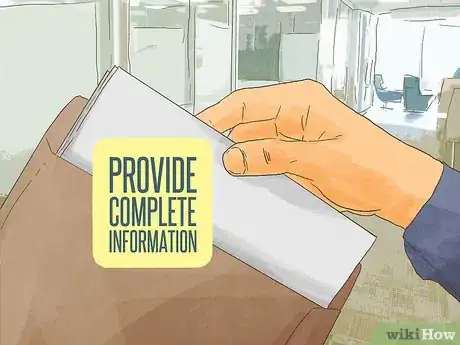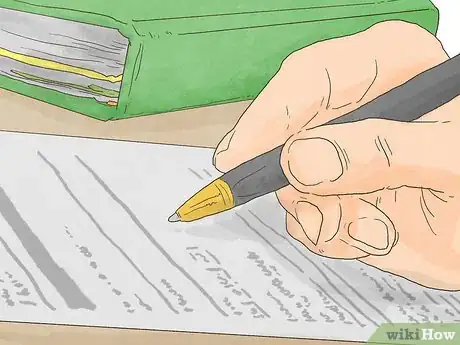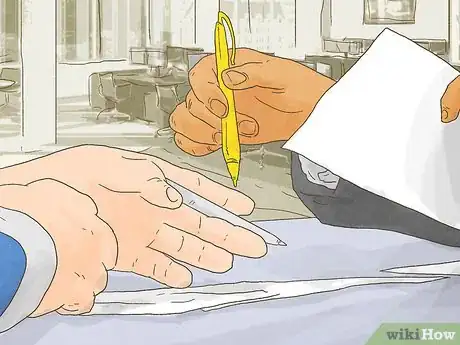This article was written by Jennifer Mueller, JD. Jennifer Mueller is an in-house legal expert at wikiHow. Jennifer reviews, fact-checks, and evaluates wikiHow's legal content to ensure thoroughness and accuracy. She received her JD from Indiana University Maurer School of Law in 2006.
There are 8 references cited in this article, which can be found at the bottom of the page.
wikiHow marks an article as reader-approved once it receives enough positive feedback. This article received 13 testimonials and 89% of readers who voted found it helpful, earning it our reader-approved status.
This article has been viewed 869,318 times.
It’s not uncommon to want to transfer your house deed to a family member, usually so that when you die, your house goes directly to the relative you want. Although transferring the deed itself is a relatively quick and simple process, you should be aware that when you transfer your deed, you lose all control and ownership interest in your house.
Steps
Using a Quitclaim Deed
-
1Obtain the form deed from the recorder or register of deeds in the county where your house is located. With a quitclaim deed, you literally quit whatever claim you have to the property -- hence the name -- and transfer it to someone else.
- Quitclaim deeds are the most common way to transfer property among family members when money doesn’t change hands, or gift property to someone.
- With a quitclaim deed, there is no risk that you might be sued by your family member or a future buyer if it turns out there’s something wrong with the deed and you didn’t have full ownership of the house, because a quitclaim deed only transfers whatever claim of ownership you have. It doesn’t guarantee that you have any particular claim.[1]
-
2Fill out the form. A quitclaim deed has blanks for your name and the name of the family member to whom you’re transferring your home.
- You also have to enter the legal description of your home. You can use the description contained in your original deed if you have access to that, or use government plats or the street address. Since it’s a quitclaim deed, the description doesn’t have to be as specific as it would be otherwise. It just has to relate back to your original deed.
- The form also will have blanks for signatures, but you shouldn’t sign the form until you are in the presence of a notary.
Advertisement -
3Sign the deed in the presence of a notary. In some states, the family member to whom you’re transferring your house deed must also sign. Some states also require additional witnesses beyond just a notary.[2]
-
4Deliver the deed by hand or certified mail. Once you sign the deed making the transfer, it needs to go to the person who now owns the property.
- If the family member to whom you transferred your house wasn’t with you when you signed the deed, you can take it to them or mail it.
- Using certified mail or similar service ensures you know when they’ve received it.
-
5Have your relative record the deed. After you’ve made the transfer, it’s the responsibility of the person to whom you transferred your house to record the deed at the county recorder’s office. Otherwise it won’t become part of the legal record of the property and could cause problems later on.
Using a TOD Deed
-
1Find out if a transfer-on-death deed is available where you live. The TOD deed enables you to maintain full control of your property while you’re alive, but transfer it to your relative of choice when you die without going through probate.
- As of 2015, 22 states and the District of Columbia offer TOD deeds, including Colorado, Illinois, Ohio and Virginia. Check with your county recorder’s office to learn if this option is available to you. If your reason for transferring your house to a family member is to avoid probate, a TOD deed may be a better solution for you because it allows you to maintain control of your house while you’re alive.[3]
-
2Draw up the deed. A TOD deed looks like any other deed, but includes a statement that it doesn’t take effect until the owner’s death. Each state has particular requirements, so you might consider consulting a real estate attorney if you’re not confident in your ability to work through those requirements on your own.
-
3Sign in front of a notary. Check your state’s law to ensure you don’t need other witnesses. The family member to whom you’re transferring your property does not need to be present.
-
4Record your deed. After you’ve signed it, you must record it yourself at your county recorder’s office. Otherwise, no one will know it exists and it may never take effect.
- You may change your mind at any time and make another deed. You retain all title and ownership in your property until you die.
- Any mortgages or other liens on your property transfer automatically with a TOD deed. Like a quitclaim deed, you’re merely bequeathing your ownership interest in the property, whatever that may be.
- When you die, your chosen family member may need to present an affidavit and death certificate to take control of the property, but it’s still a quicker and easier process than going through probate.[4]
Using a Warranty Deed
-
1Contact a real estate attorney. Because warranty deeds are the most complicated method of transferring the title to your property, you most likely will want an attorney to guide you through the process.
- Warranty deeds, sometimes called grant deeds, come with a guarantee to the new property owner that you have good title to the property and no one else has any stake in it or claim to it.[5]
- Because they are so complicated, warranty deeds typically aren’t used to transfer a house to a family member when no money is exchanged.
- Although complicated for you, a warranty deed gives the relative to whom you’re transferring your property more confidence, because you promise that you own the property free and clear of any mortgages or other encumbrances, and that no one else has a competing claim for the property.
-
2Conduct a title search on your property. Before you complete a warranty deed, a title search reviews the legal history of the property ensure the statements in the deed are correct and the title to the property is clean. This process can be expensive and time consuming.
- Although you can conduct a title search yourself, since property records are open to the public, a professional title searcher will do a more thorough job in less time than it would take you to do it yourself.
- Title insurance provides better protection against any defects in your title, either disclosed or hidden, that could cloud your deed with problems or even negate your transfer. Title insurance is expensive, and typically the cost is split between the original owner and the future owner.
-
3Complete the deed. As with other types of deeds, your deed will provide details about you and the family member to whom you’re transferring your title, as well as a complete and detailed legal description of the property.
-
4Sign the deed in front of a notary public and any other witnesses required by your state’s law.
-
5Give the deed to the relative you want to receive the property.[6]
-
6Make sure the deed is recorded. This is technically your family member’s responsibility, but if you’ve hired an attorney to draw up the deed, she may offer to record the deed herself.
- The deed is still valid if it isn’t recorded, but failure to record it can cause significant problems later on because no one else will be aware of your relative’s claim to your property.
- Not recording the deed would eliminate all the gains you made by transferring your deed, including your attempt to avoid probate.[7]
Creating a Joint Tenancy
-
1Have a new deed prepared listing you and your relative as joint tenants with right of survivorship. To have a joint tenancy, you both must acquire equal shares at the same time.
- Preparing a new deed has the effect of you selling your property to you and your relative.[8]
- Joint tenancy with right of survivorship means that when one of you dies, the other takes all interest in the property by operation of law.[9]
- Keep in mind that since you are giving someone an interest in your property, you will owe gift taxes if that share of your property is worth more than $10,000.[10]
-
2Complete the deed. Since the only thing you are changing are the names on the deed, you can simply copy everything else on your older deed.
-
3Sign the deed. Depending on your state's law, you may need to sign the deed in front of a notary public or other witnesses.
- Since you and your relative both are taking ownership of the property in this situation, you both must sign the deed.
-
4Have the deed recorded. If you want to avoid probate, the deed must be recorded or the joint tenancy won't be a matter of public record.
Warnings
- Different states often have different rules for what information deeds should contain and how they should be presented, even if they call it the same thing. Your county recorder’s office will have instructions, but if you have trouble understanding them you should consult a real estate attorney.⧼thumbs_response⧽
- When you transfer your deed -- unless you use a TOD deed -- you not only lose all control over your house, you may also have income tax issues or lose access to government benefits such as Medicaid as a result. Talk to a CPA or tax professional if these things are a concern.⧼thumbs_response⧽
References
- ↑ http://www.nolo.com/legal-encyclopedia/deeds-faq-29119.html
- ↑ https://www.ohiobar.org/forpublic/resources/lawyoucanuse/pages/lawyoucanuse-262.aspx
- ↑ http://www.nolo.com/legal-encyclopedia/deeds-faq-29119-5.html
- ↑ http://www.nolo.com/legal-encyclopedia/free-books/avoid-probate-book/chapter5-3.html
- ↑ http://realestate.findlaw.com/selling-your-home/transferring-property.html
- ↑ https://www.osbar.org/_docs/public/lioa/chapter6.pdf
- ↑ https://www.ohiobar.org/forpublic/resources/lawyoucanuse/pages/lawyoucanuse-262.aspx
- ↑ http://www.nolo.com/legal-encyclopedia/how-take-title-joint-tenancy.html
- ↑ http://realestate.findlaw.com/buying-a-home/joint-tenancy-faq.html
About This Article
To transfer a house deed to a family member right now, obtain a quit form deed. Get the required form from the recorder or register of deeds in the county where your house is located, then fill it out, sign it in front of a notary, and send it to your family member. Make sure they record the deed at the county recorder’s office so the transfer is official! To keep the house in your name for now and have the deed transferred upon your death, find out if a transfer-on-death deed is available where you live. To learn more from our Civil Litigator co-author, such as how to get a warranty deed or a joint tenancy, keep reading!

















































































